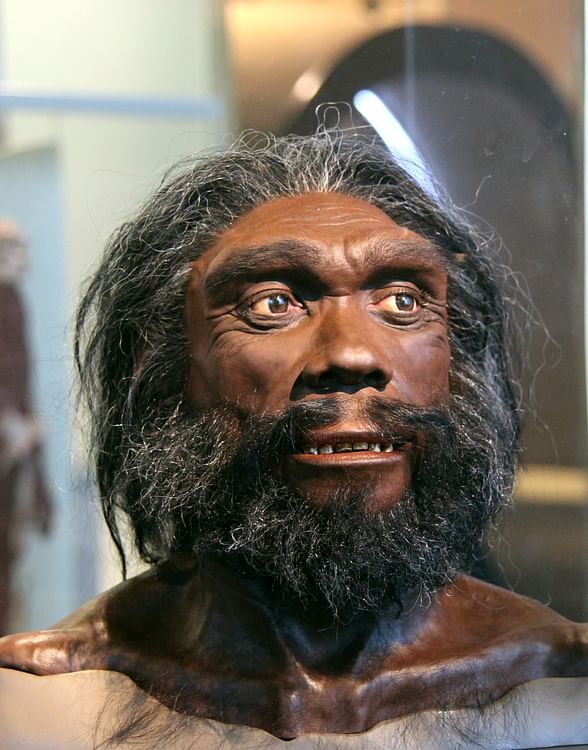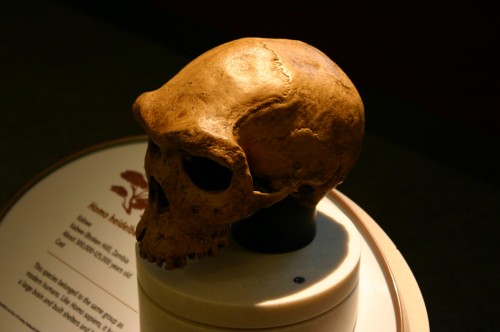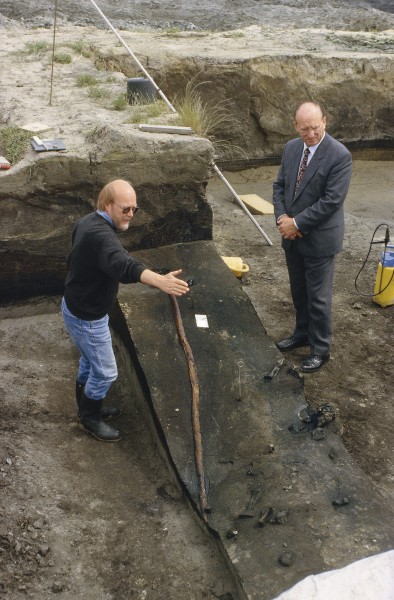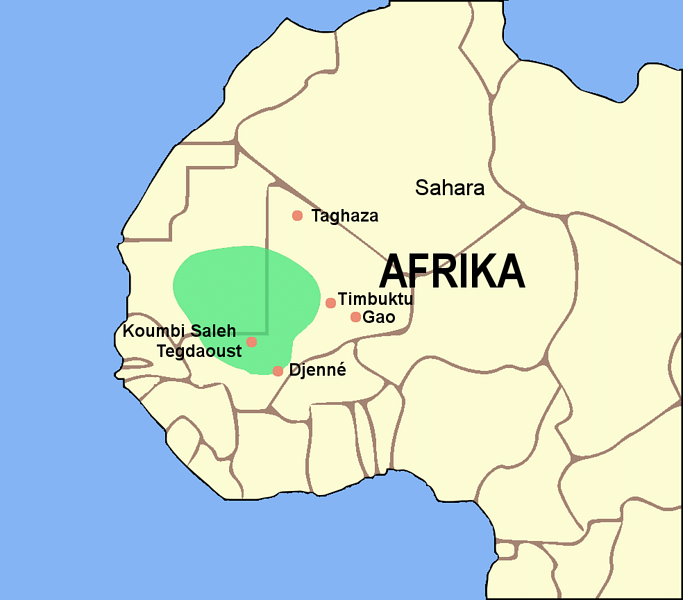Homo heidelbergensis › Ghana » Ancient origins
Articles and Definitions › Contents
- Homo heidelbergensis › Antique Origins
- Ghana › Ancient History
Ancient civilizations › Historical and archaeological sites
Homo heidelbergensis › Antique Origins
Definition and Origins

Homo heidelbergensis is an extinct species of human that is identified in both Africa and western Eurasia from roughly 700,000 years ago onwards until around 200,000 years ago – fitting snugly within the Middle Pleistocene. Named for a piece of jawbone found near Heidelberg, Germany, these hominins occupy an intriguing and much-discussed spot in the jumble of human evolution; they are most commonly seen to have developed from Homo erectus and to have given rise to Homo sapiens in Africa and to the Neanderthals in Europe. However, exactly how or why (and even if) this happened, is the subject of much debate, and the same goes for the precise definition of this species – for instance, which fossils should be included and which should not.
Following the general view, though, Homo heidelbergensis is recognised as a distinct species that was a bit more brainy and inventive than its predecessors; fairly complex tools are associated with them, allowing us to catch a glimpse of possibly quite daring hunting strategies involving larger prey animals, which hints at the potential presence of social cooperation.
DISCOVERY
In 1907 CE, the Grafenrain sandpit at the site of Mauer, near Heidelberg, Germany, became somewhat of a sensation as a robustly built jawbone of a previously unknown species of human was discovered there. After realising it had both some more primitive features as well as bits that reminded him of more recent human features, Otto Schoetensack assigned it to a distinct species he named Homo heidelbergensis in the following year. The jawbone has recently been dated to an age of around 600,000 years ago, which falls within the MIS 15 interglacial period and indicates that its owner would not have instantly frozen solid upon reaching this region.
HOMO HEIDELBERGENSIS WERE SOMEWHAT CHUNKIER VERSIONS OF OURSELVES; NOTICEABLY MORE ROBUST THAN US, BUT WITH A BRAIN SIZE ALMOST APPROACHING OUR OWN.
WHAT DID THEY LOOK LIKE?
If one was to stroll into a Middle Pleistocene cave inhabited by an average group of Homo heidelbergensis individuals, they would probably strike one as somewhat chunkier versions of ourselves; noticeably more robust than us, but with a brain size almost approaching our own – perhaps averaging somewhere around 1200 cm3 or upwards, which is markedly bigger than that of Homo erectus.
Although Heidelbergensis still had quite heavily constructed, broad faces reminiscent of Homo erectus, their brow ridges were less pronounced and their noses were more vertical like ours are, instead of sloping forward like those of Erectus. A skull from Bodo, Ethiopia, dated to approximately 600,000 years ago, is a good example of this mix of characteristics, and it can reasonably be grouped not just with other fossils from Africa, like those from Broken Hill in Zambia; Elandsfontein in South Africa; and Lake Ndutu in Tanzania; but also with individuals from Europe, such as those from Petralona in Greece, Arago in France, and generally also the mandible from Mauer, Germany.
Once the Middle Pleistocene fossil record decides to be a bit more generous, we may be able to more directly visualise the proposed development from Heidelbergensis into Sapiens in Africa and into Neanderthals in Europe. One possible example comes from the site of Boxgrove in England, Europe, which is usually assigned to Homo heidelbergensis and is thought to be around 500,000 years old. The tibia found there shows it was more robust than average Heidelbergensis specimens and indicates body proportions that were better adapted to the cold, foreshadowing those of the later Neanderthals.

Homo Heidelbergensis Skull
LIFESTYLE
These humans were hunter-gatherers - some of them well-adapted to the generally more stable and warm African terrain;another branch skilled at weaving in and out of regions in Europe along with the growing and receding ice sheets. Obviously, these bands would not have shared the exact same customs down to a tee, but we can still paint something of a general picture, with some splashes of regional colour added.
Part of this general picture involves Heidelbergensis coming home from a fruitful hunt and sticking the day's catch over a neat fire. Preferred real estate came in the shape of caves, which during the Middle Pleistocene became both more spatially structured and dotted with hearths. Although a more incidental use of fire had been around since at least 1,8 million years ago, fire remained a rare sight up until the days of Homo heidelbergensis. During its timespan, Heidelbergensis became ever more accustomed to fire and its cooking potential; we know that by at least around 400,000 years ago, humans roaming across the Old World - including the colder north, where it was particularly useful – clearly used fire in a habitual way.
Fire is already a sign of a more advanced sort of lifestyle, and this image is further supported by the tools manufactured and used by Homo heidelbergensis. Their tool kits were more sophisticated than that of Homo erectus and belonged, in contrast to the latter's early Acheulean, to the later Acheulean industry. In general, the Acheulean is characterised by large bifaces like hand axes, picks and cleavers, whereas later Acheulean tools were thinner, more finely flaked, and more symmetrical.
HUNTING PROWESS
That the tools created by Homo heidelbergensis allowed them not just to process their food and work raw materials to a satisfactory standard, but also to become adept hunters climbing further up the food chain, seems to be suggested by certain finds. At the site of Boxgrove in England, dated to around 500,000 years ago, thin and extensively flaked flint bifaces have been found together with the remains of horses and rhinoceroses. Interestingly, the animal bones bear cut marks, indicating that these large animals seem to have been killed and butchered by Heidelbergensis.
At Schöningen in Germany, things become even more exciting; eight skilfully crafted wooden throwing spears have been found, created at least 300,000 years ago. The remains of numerous horses - many of their bones cut-marked - found in the same horizon, ties in with Boxgrove and seems to indicate that Heidelbergensis systematically hunted large animals. This is no easy feat; the manufacturing of the spears shows active planning, and bringing down these dangerous animals would have required coordination and sophisticated communication.

Homo Heidelbergensis Spear
The backdrop for these activities, then, hints at a social structure that may well have been more widespread. Although wood does not usually stand the test of time very well, Heidelbergensis ' stone tools show a similarly advanced nature across its range, and unless this specific region was somehow unique in its development wooden tools could have made up an important part of these people's prehistoric tool kits. If that were indeed the case, the social implications that have been suggested for the site of Schöningen are assumed to be valid across the breadth of the species. We may yet discover more evidence to shed light on this matter.
HEIDELBERGENSIS' PLACE WITHIN EVOLUTION
Since it can sometimes be hard to confidently lump an ambiguous fossil (of which there are plenty) into species such as Homo erectus, Homo heidelbergensis, or the Neanderthals, researchers have come up with all sorts of scenarios describing the place of Heidelbergensis within evolution. Sometimes, Heidelbergensis is scrapped altogether in favour of a more broadly defined Homo erectus ; sometimes Heidelbergensis is seen as an exclusively European lineage giving rise to the Neanderthals; and the more stubborn kind of fossils associated with Heidelbergensis seem hard-pressed to attain any kind of consensus.
AROUND 700,000 YEARS AGO HOMO HEIDELBERGENSIS DEVELOPED FROM HOMO ERECTUS.
However, so far the scenario best supported by both the anatomical and the genetic evidence, of which the general lines (although not always the details) are favoured by most people, is as follows. Around 700,000 years ago (and perhaps as early as 780,000 years ago), Homo heidelbergensis had developed from Homo erectus. In Africa, they were part of a gradual, mosaic -like transition into the earliest Homo sapiens around roughly 200,000 years ago. Finds from sites such as Omo Kibish, Ethiopia; Irhoud in Morocco; and Herto in the Middle Awash region seem to showcase this.
Populations of Heidelbergensis also spread through western Eurasia, appearing north of the major mountains of Europe sometime after 700,000 years ago. Clearly adapting well to the challenging environment, the cold conditions led them to evolve the specialised facial features and more stocky build of the Neanderthals, to whom they gave rise and who appear with clear and recognisable features from roughly 200,000 onwards. Of course, with this being a gradual process, the proposed timing is subject to a lot of bickering.
There is another group that also derives from Heidelbergensis, though. In 2008 CE, a human finger bone was found in the Denisova Cave in the Altai Mountains in Siberia that turned out to belong to a separate species dubbed the Denisovans.Genetic evidence has since revealed that they are a sister species to the Neanderthals, with these two groups diverging at some point after the Heidelbergensis lineages leading to Sapiens as well as the Neanderthals and Denisovans had split.

Stringer Graph-model of Homo Evolution
This new addition just makes it even clearer how complex an evolutionary story the Pleistocene really tells. Another confusing example is the fossils at the site of Sima de los Huesos in Spain. Generally grouped within Homo heidelbergensis, these fossils are at least 430,000 years old (and perhaps up to c. 530,000 years old) and already show some Neanderthal -like features, opening up the debate for them being considered proto-Neanderthals: Heidelbergensis on their way to eventually becoming Neanderthals. Interestingly, in 2014 mitochondrial DNA was retrieved from one of the Sima fossils which showed it was closely related to the lineage leading to the Denisovans - a sister group to the Neanderthals. It is clear that the Pleistocene was home to a complex story of human evolution.
Ghana › Ancient History
Definition and Origins

Ghana was a kingdom in Africa that lasted from the 6th to the 13th century CE, located south of the Sahara desert and northwest of the Niger River in modern day Mauritania and Mali.
Thanks to the introduction of the camel into the Sahara and its increasing availability and use in Roman times in the first centuries CE, trans-Saharan trade routes (north-south) became feasable, allowing African societies in the Sahel access to the markets of the Mediterranean Sea. As these routes grew more profitable, cities such as Djenne Jeno and Gao arose and in time more complex and powerful territorial states appeared, with Ghana being the first of them.
The people who formed the Ghana kingdom were the Soninke, a subgroup of the Mande-speaking family. They called their kingdom Wagadu, but we know it as Ghana, the name the Arabs gave it. The kingdom's golden age began around 800 CE and lasted for nearly three centuries. Ghana's capital changed several times but the last and most famous of them was Kumbi (or Koumbi Saleh), perhpas founded in the 4th century CE. It became the biggest city south of the Sahara with some 15,000 inhabitants at its peak.
The trading activities that constituted the backbone of Ghana's economy were the sale of gold, kola nuts (the later “secret ingredient” of Coca-Cola), and ivory to cities along the Mediterranean, in exchange for salt. The Soninke were intermediaries, as they did not control the sources of most of these products, which came from further south, while the actual transport of the goods to the north was completed by nomadic, camel-riding Berbers.
Thanks to the introduction of the camel into the Sahara and its increasing availability and use in Roman times in the first centuries CE, trans-Saharan trade routes (north-south) became feasable, allowing African societies in the Sahel access to the markets of the Mediterranean Sea. As these routes grew more profitable, cities such as Djenne Jeno and Gao arose and in time more complex and powerful territorial states appeared, with Ghana being the first of them.
The people who formed the Ghana kingdom were the Soninke, a subgroup of the Mande-speaking family. They called their kingdom Wagadu, but we know it as Ghana, the name the Arabs gave it. The kingdom's golden age began around 800 CE and lasted for nearly three centuries. Ghana's capital changed several times but the last and most famous of them was Kumbi (or Koumbi Saleh), perhpas founded in the 4th century CE. It became the biggest city south of the Sahara with some 15,000 inhabitants at its peak.
The trading activities that constituted the backbone of Ghana's economy were the sale of gold, kola nuts (the later “secret ingredient” of Coca-Cola), and ivory to cities along the Mediterranean, in exchange for salt. The Soninke were intermediaries, as they did not control the sources of most of these products, which came from further south, while the actual transport of the goods to the north was completed by nomadic, camel-riding Berbers.
THE SONINKE CALLED THEIR KINGDOM WAGADU, BUT WE KNOW IT AS GHANA, THE NAME THE ARABS GAVE IT.
Ghana's prosperity relied heavily on the Berber's caravans, which were organized independently by Berber chiefs and merchants: they were the only link to the outside world. This relationship was tenuous, though, as the Berbers usually complimented their income with raids on civilized lands. Only the mutual interest in trade profit kept the relationship stable, and indeed it worked for centuries.
However, as Ghana grew richer and expanded its territorial base, tensions with various tribes of Berber merchants grew as well. The Berbers resented the increasing power of trading cities, dominated by the Soninke. With the conquest by Ghana of the independent and important city-state of Audaghost, relations became much more hostile. At the dawn of the 11th century CE, the Berbers, who used to be the masters of Audaghost's commerce, repeatedly attempted to free the city from Ghana's control.
In the mid 11th century CE, the Almoravid dynasty of Morroco (r. 1040–1147 CE) began to attract large numbers of Berbers, thus providing a more solid form of organization and unity to the otherwise conflicting Berber clans. The Almoravids became powerful enough to launch conquest campaigns abroad. To the north they invaded Spain (Al-Andalus), defeating the Caliphate of Córdoba (r. 929-1031 CE). To the south, the Almoravids brought havoc to Ghana, even conquering the capital city, Kumbi, in 1076 CE. Although Ghana was eventually able to expel the invaders, the damage was staggering. Ghana's networks of trade were perturbed (Audaghost quickly lost all importance, for example), but also the introduction of Berber's pasturing flocks in what used to be agricultural land, initiated a terrible process of desertification.
Ghana would not recover its former glory and the following decades saw further decline as subject peoples broke free from the kingdom's control. In 1203 CE, Kumbi was taken by one of their former subject peoples: the Susu. In 1240 CE, the kingdom collapsed when the Kumbi was devastated yet again and the heart of Ghana was annexed by the rising Empire of Mali (c. 1230-1600 CE).
However, as Ghana grew richer and expanded its territorial base, tensions with various tribes of Berber merchants grew as well. The Berbers resented the increasing power of trading cities, dominated by the Soninke. With the conquest by Ghana of the independent and important city-state of Audaghost, relations became much more hostile. At the dawn of the 11th century CE, the Berbers, who used to be the masters of Audaghost's commerce, repeatedly attempted to free the city from Ghana's control.
In the mid 11th century CE, the Almoravid dynasty of Morroco (r. 1040–1147 CE) began to attract large numbers of Berbers, thus providing a more solid form of organization and unity to the otherwise conflicting Berber clans. The Almoravids became powerful enough to launch conquest campaigns abroad. To the north they invaded Spain (Al-Andalus), defeating the Caliphate of Córdoba (r. 929-1031 CE). To the south, the Almoravids brought havoc to Ghana, even conquering the capital city, Kumbi, in 1076 CE. Although Ghana was eventually able to expel the invaders, the damage was staggering. Ghana's networks of trade were perturbed (Audaghost quickly lost all importance, for example), but also the introduction of Berber's pasturing flocks in what used to be agricultural land, initiated a terrible process of desertification.
Ghana would not recover its former glory and the following decades saw further decline as subject peoples broke free from the kingdom's control. In 1203 CE, Kumbi was taken by one of their former subject peoples: the Susu. In 1240 CE, the kingdom collapsed when the Kumbi was devastated yet again and the heart of Ghana was annexed by the rising Empire of Mali (c. 1230-1600 CE).
LICENSE:
Article based on information obtained from these sources:with permission from the Website Ancient History Encyclopedia
Content is available under License Creative Commons: Attribution-NonCommercial-ShareAlike 3.0 Unported. CC-BY-NC-SA License